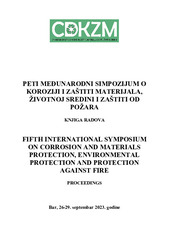Приказ основних података о документу
Nucleation and growth of tin dendrites from alkaline electrolyte
Nukleacija i rast dendrita kalaja iz alkalnog elektrolita
| dc.creator | Nikolić, Nebojša D. | |
| dc.creator | Lović, Jelena D. | |
| dc.creator | Milošević, Dragana | |
| dc.creator | Stevanović, Sanja | |
| dc.date.accessioned | 2023-10-25T14:40:51Z | |
| dc.date.available | 2023-10-25T14:40:51Z | |
| dc.date.issued | 2023 | |
| dc.identifier.isbn | 978-9940-9334-4-9 | |
| dc.identifier.uri | https://cer.ihtm.bg.ac.rs/handle/123456789/6791 | |
| dc.description.abstract | Procesi nukleacije i rasta dendrita kalaja iz alkalnog hidroksidnog elektrolita su istraženi hronoamperometrijom i skenirajućom elektronskom mikroskopskom (SEM) analizom taloga potenciostatski elektrohemijski istaloženih na selektivnim katodnim potencijalima. Za određivanje tipa nukleacije korišćen je model Šarifkera i Hilsa (SH) zasnovan na trodimenzionalnoj nukleaciji sa difuziono kontrolisanim rastom. Bez obzira na primenjeni katodni potencijal, dobijene bezdimenzionalne zavisnosti su bile niže od teorijskih predviđanja za progresivni tip nukleacije. Sa druge strane, morfologija dendrita kalaja je snažno zavisila od primenjenog katodnog potencijala, te igličasti ili dendriti nalik paprati su bili formirani potenciostatskim režimom elektrohemijskog taloženja. Na osnovu morfološke analize Sn dendrita elektrohemijski istaloženih različitim količinama elektriciteta, zaključeno je da nukleacija Sn iz ispitivanog elektrolita ipak sledi progresivni tip, i da se odstupanje od teorijskih predviđanja za ovaj tip može pripisati upotrebi kompleksnog elektrolita za elektrohemijsko taloženje kalaja. | sr |
| dc.description.abstract | The processes of nucleation and growth of tin dendrites from alkaline hydroxide electrolyte have been investigated by chronoamperometry and by the scanning electron microscopic (SEM) analysis of the deposits potentiostatically electrodeposited at the selected cathodic potentials. The Scharifker and Hills (SH) model based on three dimensional nucleation with diffusion controlled growth was used for a determination of a nucleation type. Irrespective of the applied cathodic potential, the obtained dimensionless dependencies were lower than the theoretical predictions for the progressive type of nucleation. On the other hand, morphology of Sn dendrites strongly depended on the applied cathodic potential, and either the needle-like or the fern-like dendrites were formed by the potentiostatic regime of electrodeposition. On the basis of the morphological analysis of Sn dendrites electrodeposited with various amounts of the electricity, it is concluded that nucleation of Sn from the examined electrolyte still follows the progressive type, and that the deviation of the theoretical predictions for this type can be attributed to use of complex electrolyte for Sn electrodeposition. | sr |
| dc.language.iso | en | sr |
| dc.publisher | Crnogorsko društvo za koroziju, zaštitu materijala i zaštitu životne sredine | sr |
| dc.relation | info:eu-repo/grantAgreement/MESTD/inst-2020/200026/RS// | sr |
| dc.relation | info:eu-repo/grantAgreement/ScienceFundRS/Ideje/7739802/RS// | sr |
| dc.rights | openAccess | sr |
| dc.rights.uri | https://creativecommons.org/licenses/by/4.0/ | |
| dc.source | 5th International symposium on corrosion and materials protection, environmental protection and protection against fire, Proceedings, 26-29. September 2023, Bar / Peti međunarodni simpozijum o koroziji i zaštiti materijala, životnoj sredini i zaštiti od požara, knjiga radova, 26-29. septembar 2023 godine, Bar | sr |
| dc.subject | tin dendrites | sr |
| dc.subject | nucleation | sr |
| dc.subject | growth | sr |
| dc.subject | electrodeposition | sr |
| dc.title | Nucleation and growth of tin dendrites from alkaline electrolyte | sr |
| dc.title | Nukleacija i rast dendrita kalaja iz alkalnog elektrolita | sr |
| dc.type | conferenceObject | sr |
| dc.rights.license | BY | sr |
| dc.citation.spage | 57 | |
| dc.citation.epage | 63 | |
| dc.citation.rank | M33 | |
| dc.identifier.rcub | https://hdl.handle.net/21.15107/rcub_cer_6791 | |
| dc.identifier.fulltext | http://cer.ihtm.bg.ac.rs/bitstream/id/27560/bitstream_27560.pdf | |
| dc.type.version | publishedVersion | sr |
Документи
Овај документ се појављује у следећим колекцијама
-
AdCatFC
Advanced Catalysts for Low Temperature Fuel Cells: From Model System to Sustainable Catalysts -
Radovi istraživača / Researchers' publications


